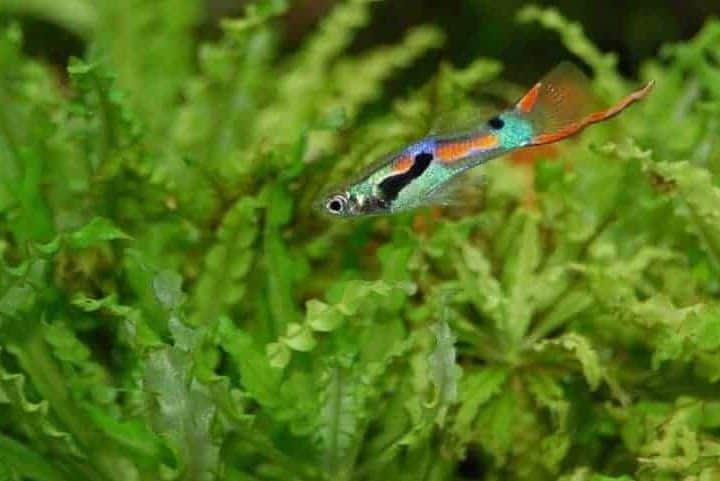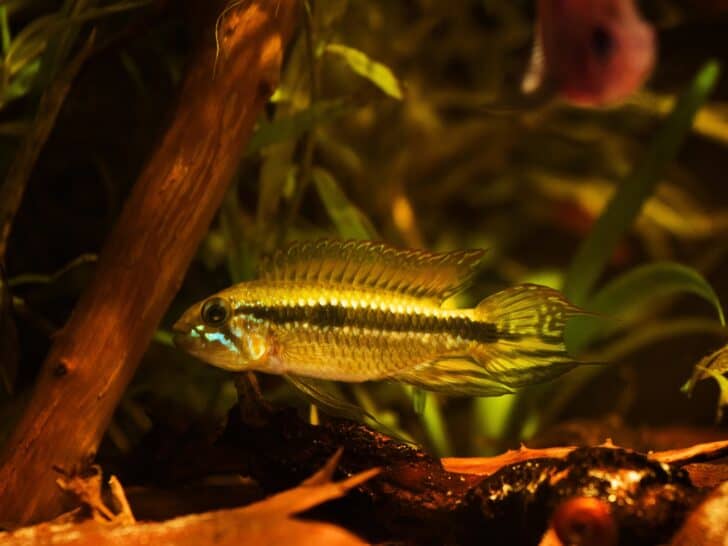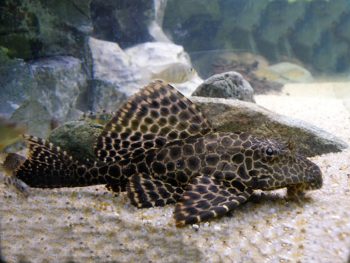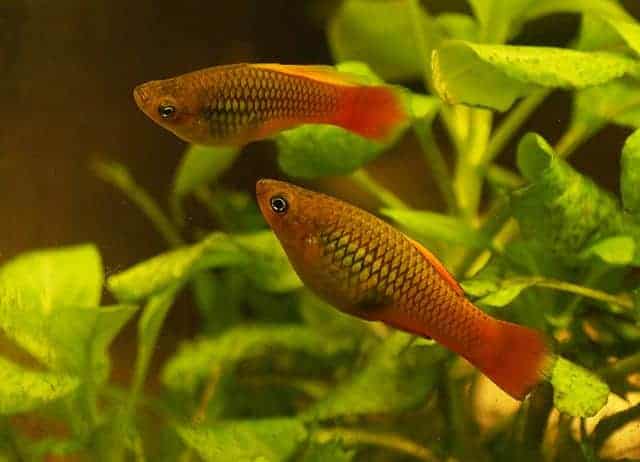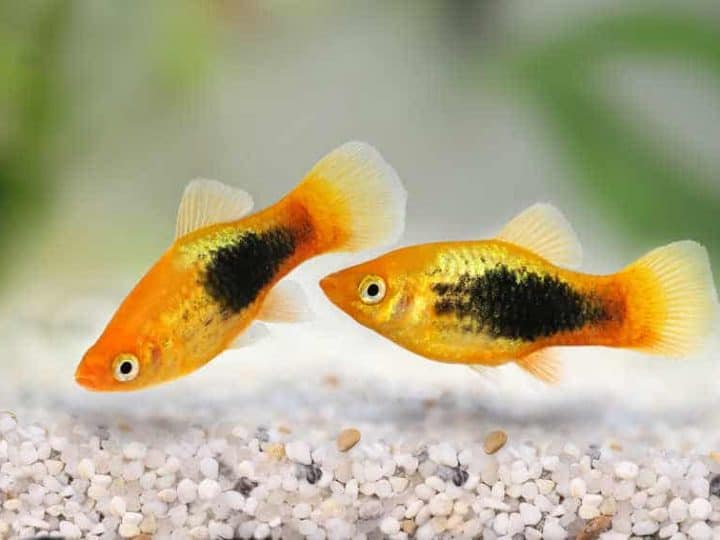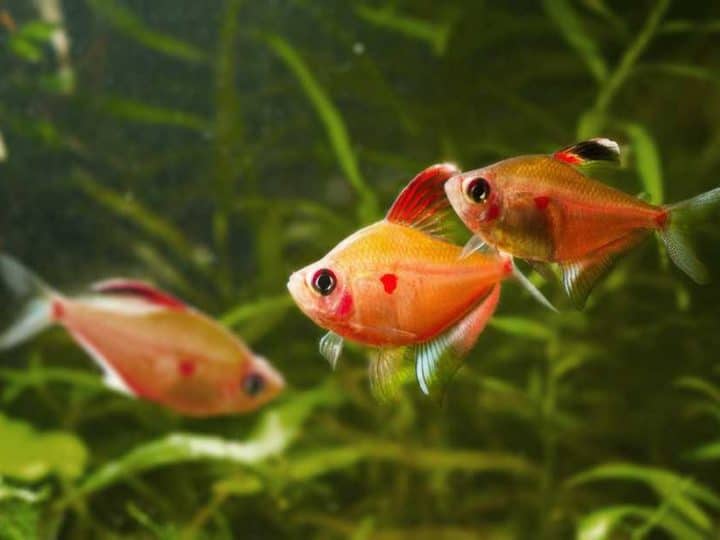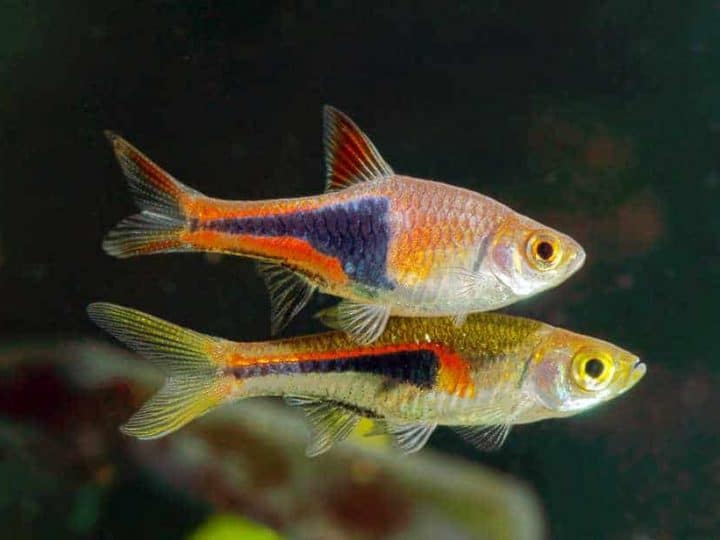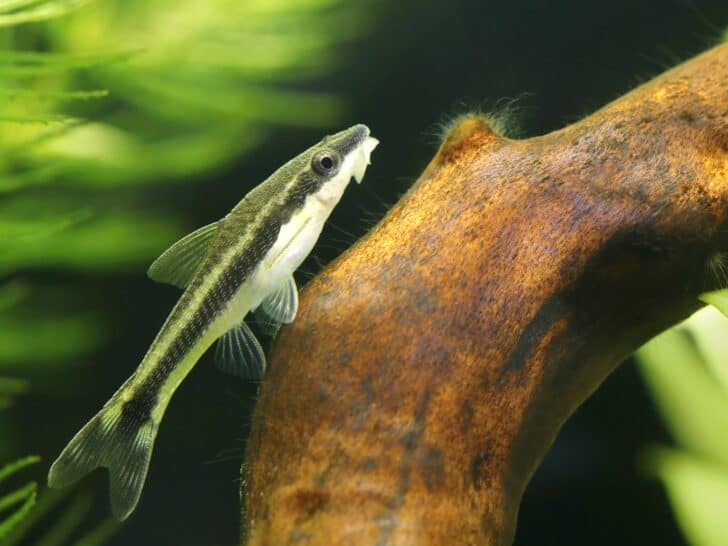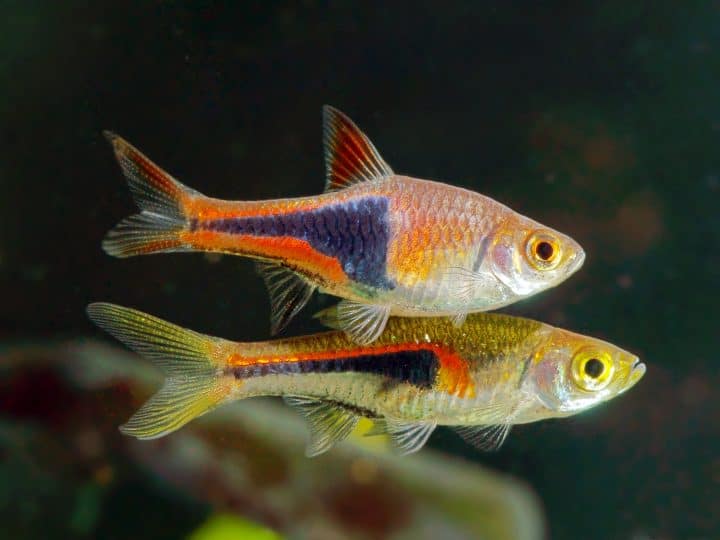When I started to think about what to add to my 20 gallon aquarium, I remember struggling with what fish could go together and what fish should be in a community tank. I was a complete beginner! Since then I have learned a lot and will now provide you with a lot of answers you probably have when looking for inspiration for your new aquarium!
Compose the perfect beginner community aquarium
A good community tank consists of a school of fish, a centerpiece fish and some bottom feeders. This is also the way this article is structured. The first section is going to cover livebearers as they are very rewarding to keep and perfectly suitable to add to a community tank.
This article will guide you through all the choices you have when deciding what fish to add to your beginner community tank. Without further ado, let us jump straight in!
Livebearers
Perfectly suitable for community tanks are livebearer fish. These fish are great to keep for beginners as they are extremely easy to breed. All they need are steady decent water parameters and food. Seeing the baby fish grow to adults is amazing to see, and therefore I recommend everyone to keep livebearer fish in their community tank.
While all livebearers are beautiful, I would recommend to keep only one species in your aquarium. The reason for this is because they can actually cross-breed. Another reason is because you most likely are going to add other fish to your community tank!
1. Mollies
Mollies are livebearers and come in different colors and varieties. The most popular variety arguably is the black molly. When breeding mollies, try keeping different colors together as this will give beautiful color variation in the offspring. Keep the fish in a male/female ratio of 1:3.
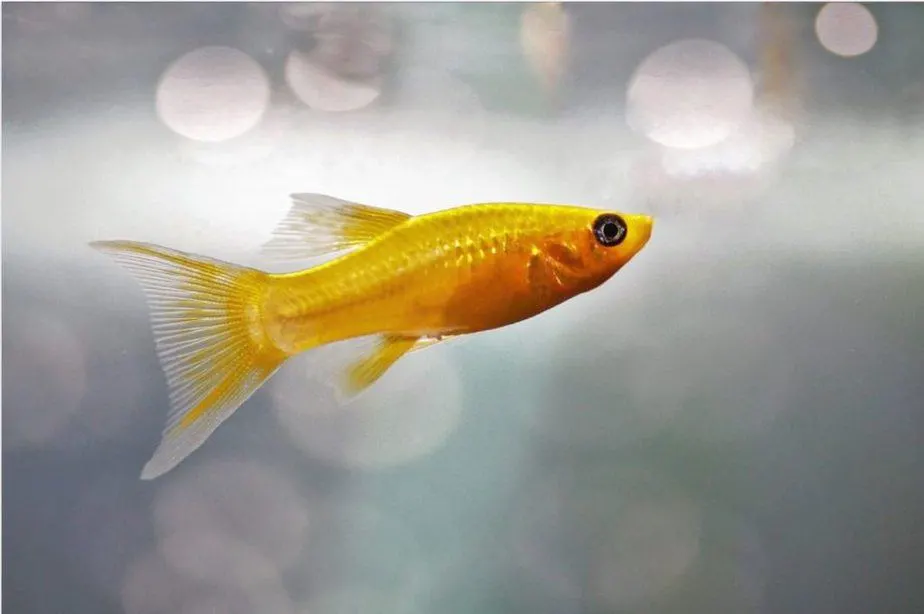
| Temperature | 70-85⁰ Fahrenheit. |
| pH | 7.0 – 8.0 |
| Adult size | 3 – 4 inches |
| Minimum tank size | 20 gallons |
| Tips | Keep in male/female ratio of 1:3 |
Mollies are orginally from South America and are very peaceful fish as long as you keep enough females with the males in the same tank. They are perfect for beginners.
2. Guppies
Guppies are extremely popular in the aquarium hobby, especially amongs beginners. They are livebearers that breed like crazy. There are different varieties of fancy guppies, and there are also endler guppies. The picture below shows three endler guppy males with one female. Whenever you keep guppies make sure you keep one male with 3 females.
Tip: The reason for the 1:3 male to female ratio is to divide the attention of a male across multiple females. This way, the female fish do not get too stressed.
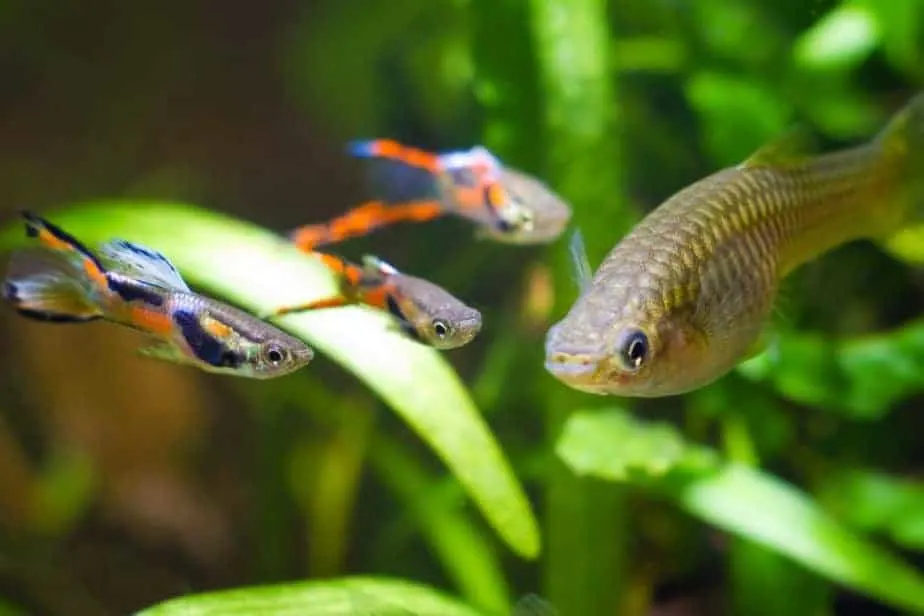
| Temperature | 70-82⁰ Fahrenheit. |
| pH | 6.0 – 8.0 |
| Adult size | 0.6 – 2.4 inches |
| Minimum tank size | 5 – 10 gallons |
| Tips | Keep in male/female ratio of 1:3 |
3. Swordtails
These fish are pretty large for livebearers and are extremely pretty. On the picture below you can see why did deserved their name, and look at those colors! There are multiple varieties available. They are quite hardy and really peaceful so therefore they make excellent beginner aquarium fish.
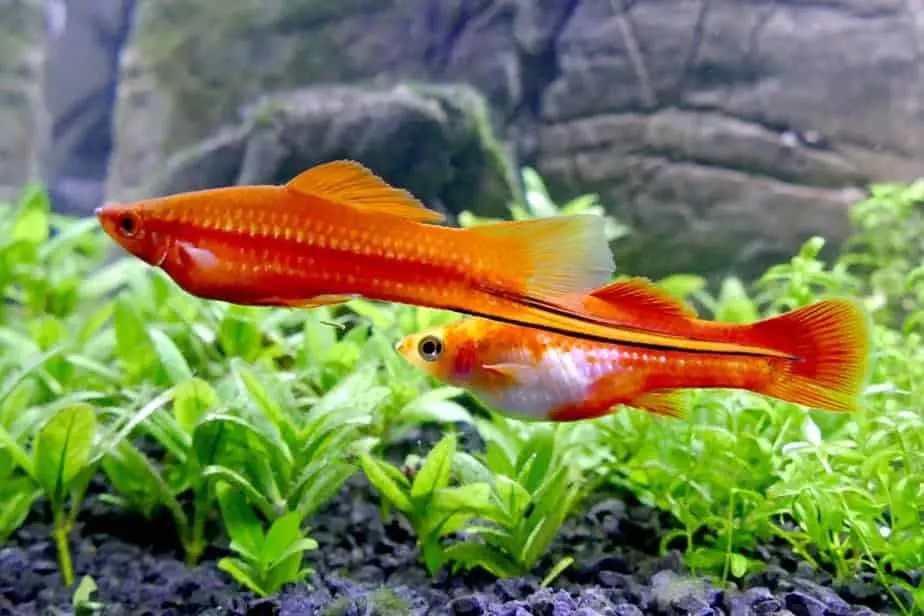
| Temperature | 65 – 82⁰ Fahrenheit. |
| pH | 7.0 – 8.0 |
| Adult size | 5 – 6 inches |
| Minimum tank size | 20 gallons |
| Tips | Keep in male/female ratio of 1:3 |
Swordtails are great jumpers so make sure to add a cover to your aquarium to prevent them from jumping out of the aquarium. The minimum tank size is 20 gallons but it is better to house these fish in at least a 29 gallon tank when you plan on adding other fish.
Because they are quite hardy, you do not have to chase the perfect water parameters. Instead, make sure the parameters are stable, this will minimize stress to the fish.
4. Platies
Platies are beautiful small active fish that are a perfect addition to your beginner aquarium. They are rather peaceful which means you can add a lot of different fish with them in the tank. There are many varieties such as high fins or different color varieties. For these fish it is also important that you keep between 3 and 4 females for every male.
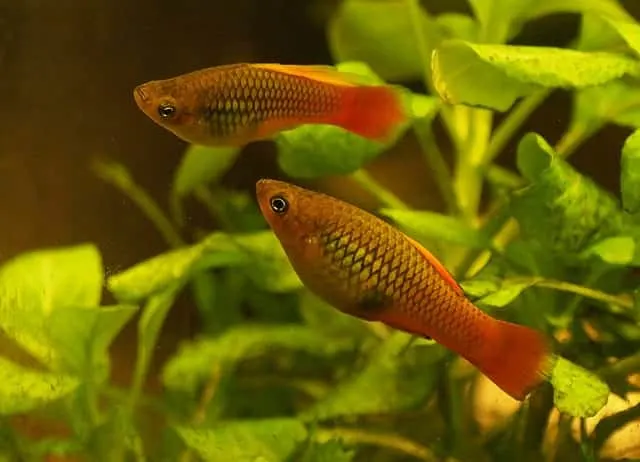
| Temperature | 70-80⁰ Fahrenheit. |
| pH | 6.8 – 8.0 |
| Adult size | around 3 inches |
| Minimum tank size | 10 gallons |
| Tips | Keep in male/female ratio of 1:3 |
Schooling Fish
Every community tank needs a group of fish that stick together. They’re often called schooling fish or shoaling fish (interchangeably). My first schooling fish was a group of 5 ember tetras. Overall, schooling fish will add a sense of calmness to the tank.
5. Tetras
There are many many different tetras available that are all super suitable fish for a beginner community tank. Popular examples are cardinal- (on the picture below), neon-, rummy nose-, ember-, fire- and neon tetras. I included more of these in my list of best schooling fish if you want to know more about the different kinds.
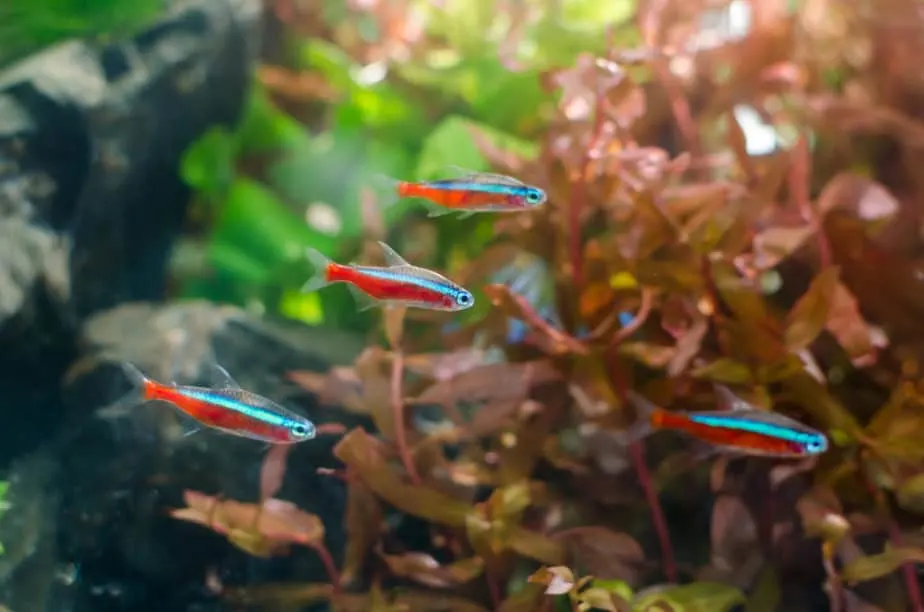
| Cardinal Tetra | |
| Temperature | 73-81⁰ Fahrenheit. |
| pH | 5.0-7.0 |
| Adult size | up to 2 inches |
| Minimum tank size | 20 gallons |
| Tips | Keep at least 5 fish in a school |
The neon tetra looks similar to the cardinal tetra. You can keep them apart by knowing the following: neon tetras have a blue front and red back, while cardinals have a blue top and red bottom. Compare the neon tetra image with the cardinals above:
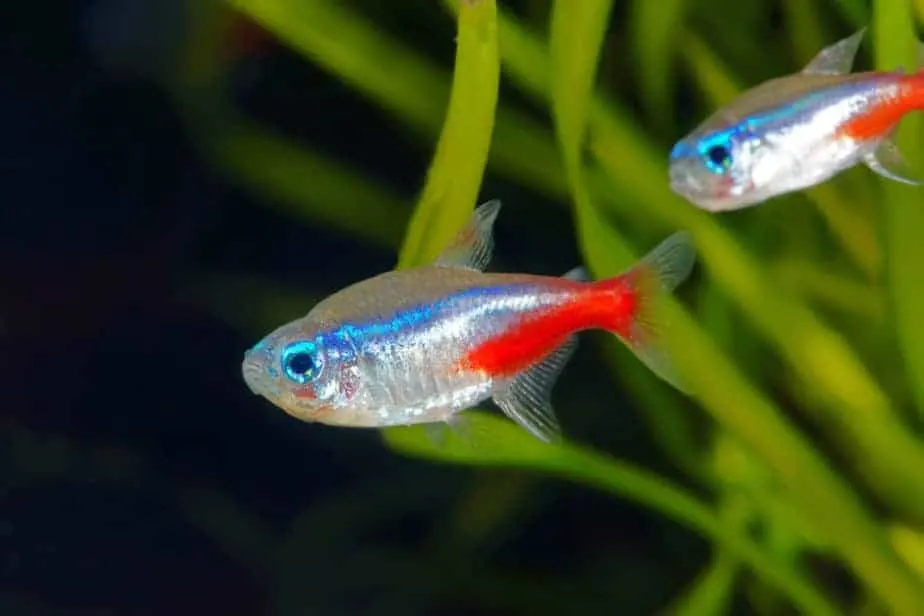
I personally love the rummy nose tetra, shown on a picture below. These fish have beautiful red noses when kept in big schools with good water condition. They can also serve as an indicator of the tank water quality, as they loose their color when the water condition decreases.
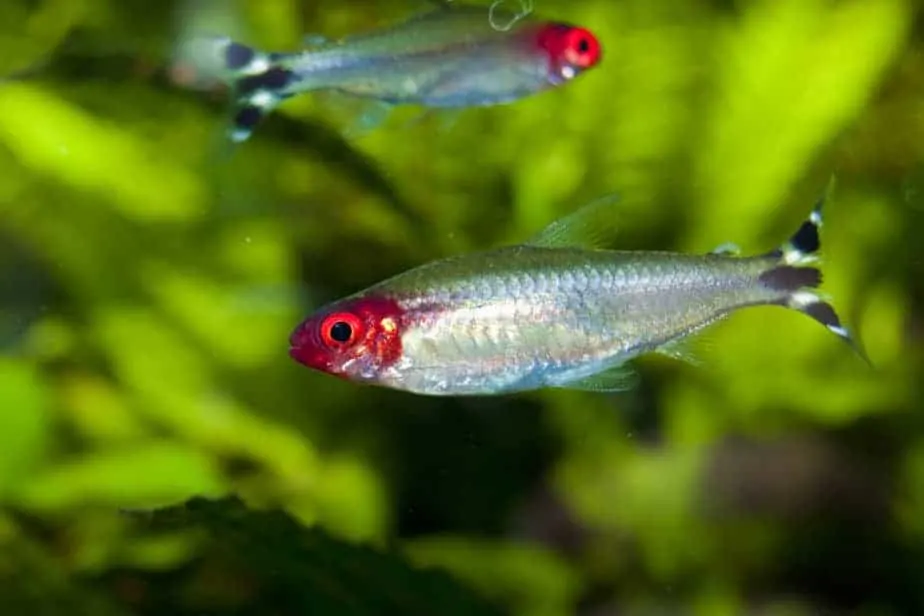
6. Rasboras
There are so many different kind of rasboras available to us! One of the most popular is the Harlequin “pork chop” rasbora. These peaceful fish make for a perfect school in your community aquarium. They school really tight which make them so interesting to look at. Adding a big school of these to your tank is a good choice for sure!
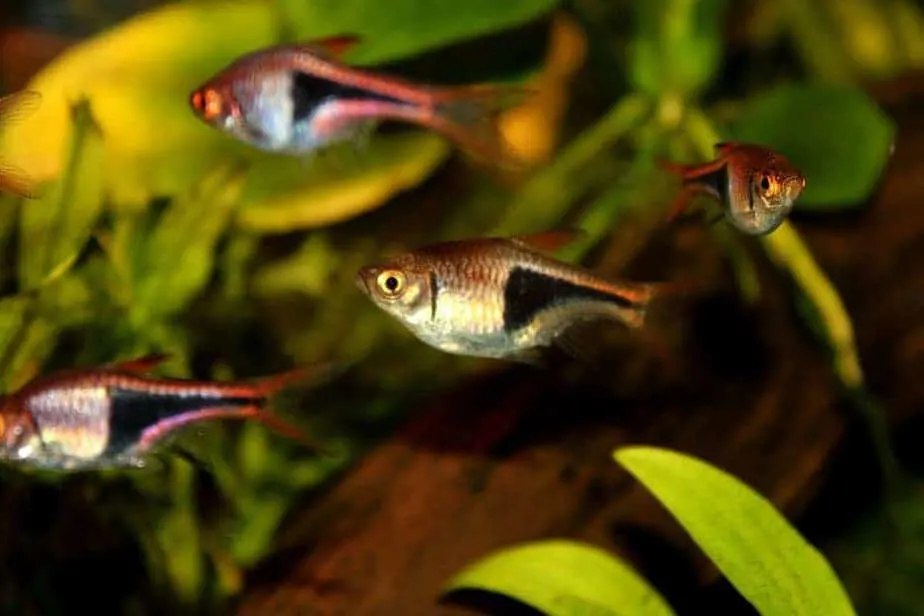
| Temperature | 72-81⁰ Fahrenheit. |
| pH | 6.0 – 7.8 |
| Adult size | up to 2 inches |
| Minimum tank size | 10 gallons |
| Tips | Keep at least 5 fish in a school |
These harlequin rasboras are timid and peaceful fish that will not harm anyone in your aquarium. Due to their peaceful nature it is more likely that they themselves will become stressed by boisterous fish.
Check these fish out at your local fish store if you have the chance! You will see what I mean by their beautiful shoaling behavior.
7. Barbs
If you are looking for a more dominant fish tiger barbs are for you. These fish are the least suitable for beginners on this list. If you want to successfully keep these beauties you must keep them in big groups to disperse aggression. They are notorious fin-nippers so do not keep them in the same tank as peaceful fish or fish with long fins. Their temper is the only thing holding me back as they are so extremely beautiful!
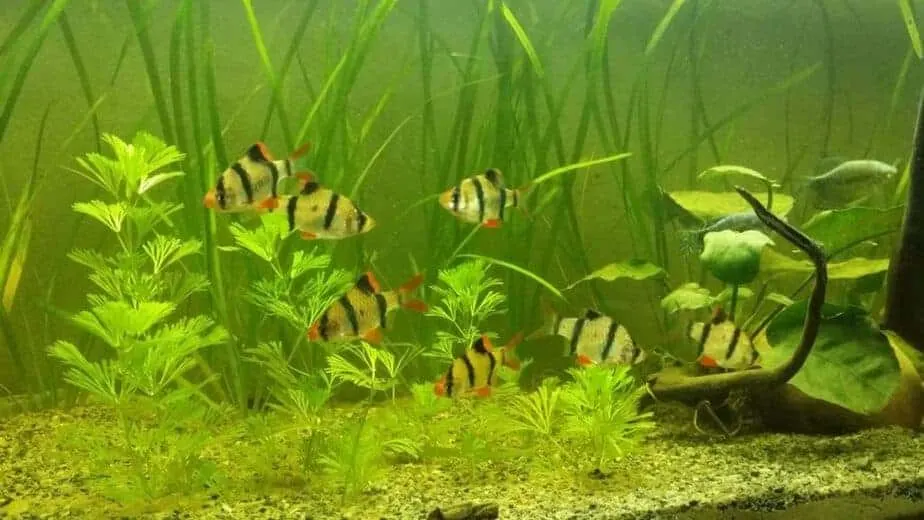
| Temperature | 77-82⁰ Fahrenheit. |
| pH | 6.0 – 8.0 |
| Adult size | 2 – 3 inches |
| Minimum tank size | 20 gallons for 5 |
| Tips | Keep at least 5, but bigger groups is better! They are can be aggressive but you can also refer to them as active and playful. |
These fish are a lot of fun and should be classified as beginner – intermediate level fish. They come in many different colors and variations. The most popular is the regular tiger bard which has 4 bands and high contrast. They can also come in different colors, more bands or no bands.
Here is a picture of a 5 banded barb (pentazona barb):
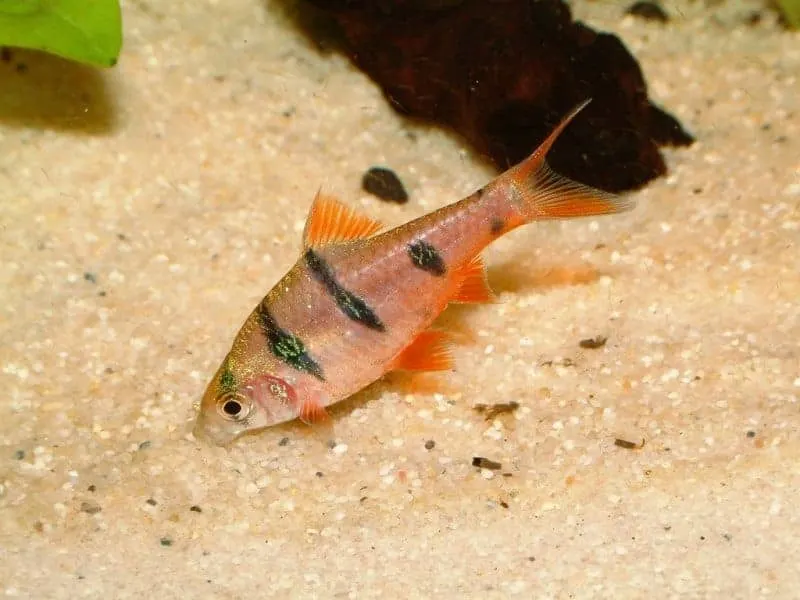
Centerpiece Fish
Now let’s move to choosing a centerpiece fish. This is going to be your “crown jewel” of the community aquarium. I must admit I do not love them more compared to watching a schooling fish but they are very pretty indeed.
You should not choose multiple centerpiece fish when you have a medium sized aquarium (around 20 gallon / 100 L). It is best to choose just one species.
8. Gouramis
My first love! Gourami fish! There are a handful of varieties like the pearl gourami, gold gourami and the opaline gourami. My grandfather has two female pearl gouramis that I absolutely loved, and they got me interested in keeping fish. They are extremely calm and move rather elegant. They create bubble nests at the water surface where they hatch their eggs.
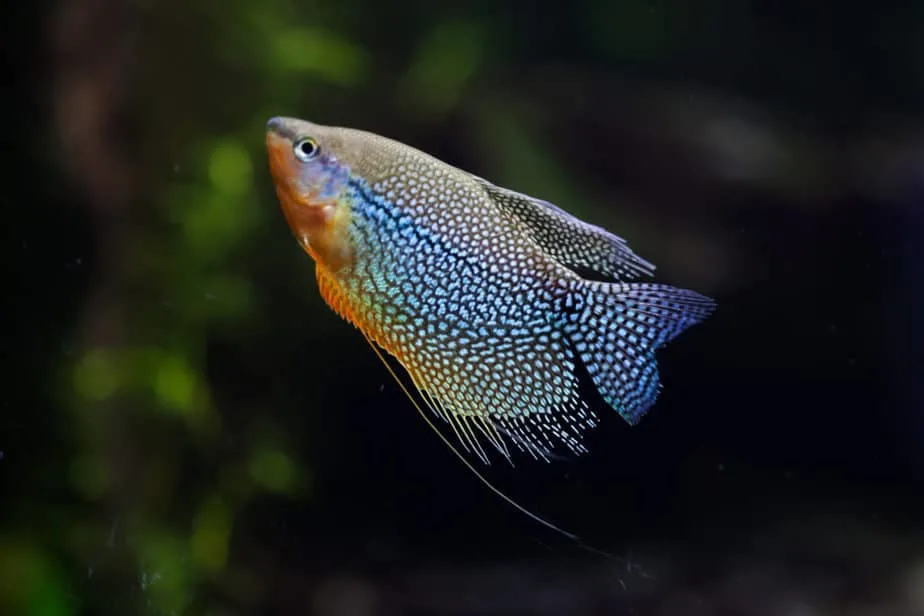
| Temperature | 77-82⁰ Fahrenheit. |
| pH | 6.0 – 8.0 |
| Adult size | 4 – 5 inches |
| Minimum tank size | 20 gallons for one, 30 gallon for a breeding pair |
| Tips | These fish prefer little surface water flow and like floating plants. |
These fish are rather popular for obvious reasons. Their colors are insane and the way they move through your aquarium is mesmerizing. You will find them swimming in the mid/top section of the aquarium.
They also have the rather special ability to get oxygen from the air so you might catch they taking a breath of air. This is perfectly normal and does not mean there is not sufficient oxygen in your aquarium water.
Adding floating plants will provide them with more cover in your aquarium which is something they will prefer.
9. Rainbow Kribs
Trust me when I say adding regular African or South American cichlids to your community is a bad idea as they grow way too big. This is a shame as their behavior and colors are awesome! Luckily you can add dwarf-cichlids, which show the intriguing cichlid behavior. The most popular dwarf-cichlid is the rainbow kribensis.
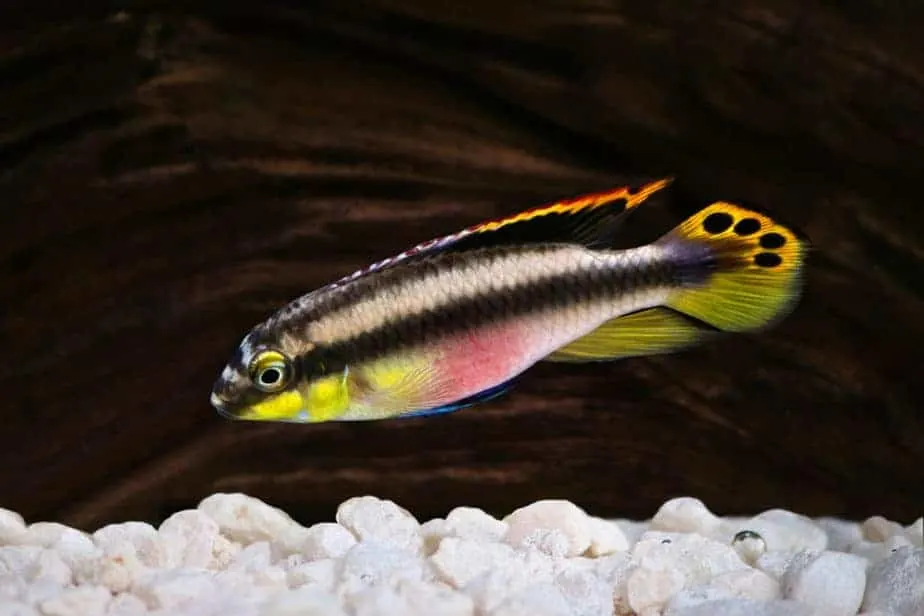
| Temperature | 75-78⁰ Fahrenheit. |
| pH | 6.0 – 7.0 |
| Adult size | 3 – 4 inches |
| Minimum tank size | 20 gallons |
| Tips | Add rocks and driftwood to create little caves. You will see these fish swimming in and out of these little caves all day long. It is amazing behavior to watch. |
These fish are amazing to add to your aquarium. They are rather easy to breed, as I have done a couple of times. All they need is the right water parameters and good protein rich food like most frozen food. This is a picture of some of the fry I had last year.
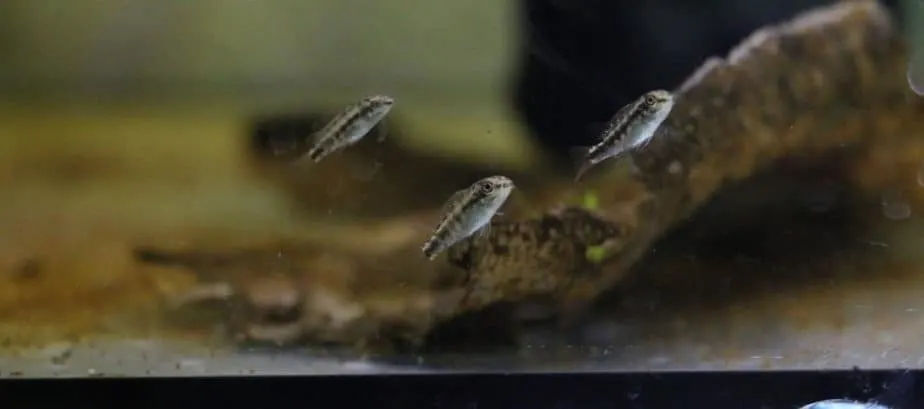
10. Bolivian Rams
Another dwarf-cichlid that is really suitable as a beginner centerpiece fish in your community tank is the bolivian ram cichlid. While a little less colorful compared to the German Blue ram, it is also quite a bit more tolerant to different water parameters and therefore more hardy. They are also easier to breed in your aquarium. I personally love these! Their behavior is interesting to see, so go check them out in your local fish store.
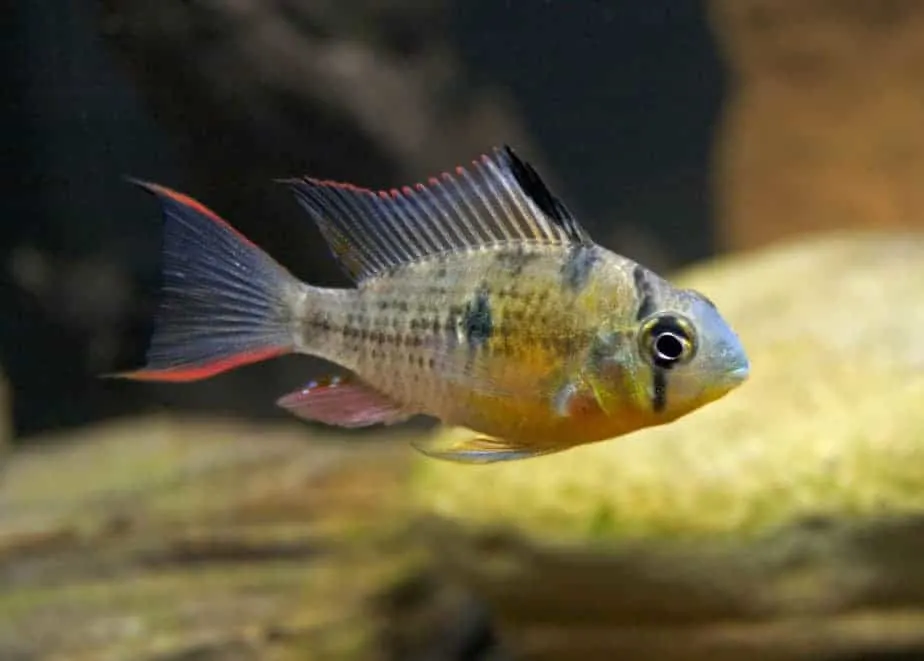
| Temperature | 74-78⁰ Fahrenheit. |
| pH | 6.0 – 7.4 |
| Adult size | 3.5 inches |
| Minimum tank size | 30 gallons |
| Tips | Make sure to get a male and a female. Two males will fight to the death. Two females is fine as well. They can also be kept alone. |
The way these fish will move and stay still in your aquarium will amaze you. They have this way of staying in one place that is tough to describe in words. The way they eat is also quite iconic and enjoyable to watch.
Do not get only males as they will fight and most likely will not stop until there is just one male left. Instead, get just one male with females or just females. It can be tough to tell what sex they are when they are still small in your fish store. Therefore, ask your fish store if you are allowed to swap them when they turn out to be the “wrong” sex. This will make sure you end up with happy fish.
11. Angelfish
Angelfish are beginner fish, but require a big tank! I hear too many people who want to keep them in a 20 gallon. These fish require a big and preferably high aquarium to thrive. Angelfish are beautiful and rather calm. They grow quite big and therefore there is discussion whether they can go with smaller schooling fish. In my experience this can be fine based on the personality of the fish.
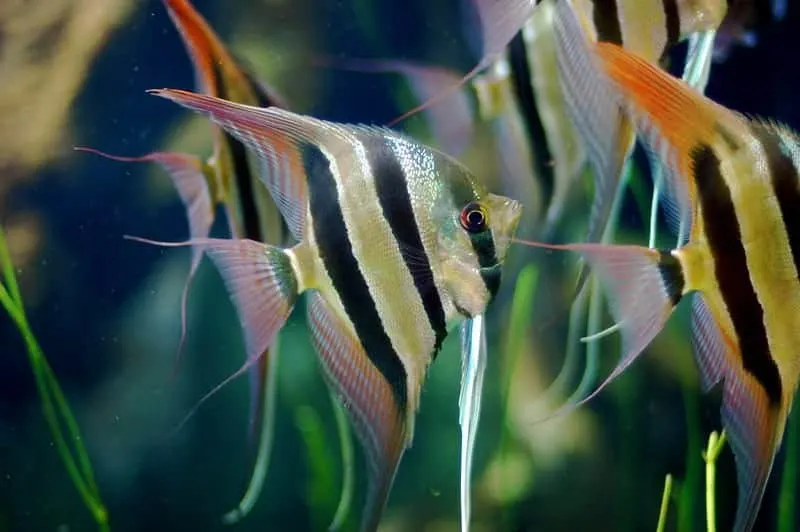
| Temperature | 75-82⁰ Fahrenheit. |
| pH | 6.8 – 7.0 |
| Adult size | 6 inches long and 8 inches tall |
| Minimum tank size | 29 gallons for a pair, >80 gallons for a small school |
| Tips | These fish grow tall, so make sure you have a high aquarium for them to live in. |
Do not keep these fish with barbs as they are notirous fin nippers. Other good tank mates for angelfish include the bolivian ram, dwarf cichlids, gouramis, mollies and small freshwater catfish. Note that your tank should be big enough for the fish together.
Angelfish often lay eggs when kept in an aquarium. In theory the parents will take care of the eggs and fry, but they do need some practice. This means that the first batches of eggs will most likely be eaten.
Bottom Feeders / Clean-up Crew
The next choice you have to make is what kind of bottom feeder you want to keep in your aquarium. These fish will inhabit the bottom of your tank and will look for leftover food. Some people refer to these fish as your “clean-up crew”. While they help cleaning, make sure you also feed them as they can not live from leftovers alone.
12. Corydoras Catfish
Corydoras are schooling fish that together will sift through your substrate looking for food. They are always busy and super interesting to watch. There are many varieties out there so choose wisely. Make sure to have fine sand substrate as this is what they prefer.
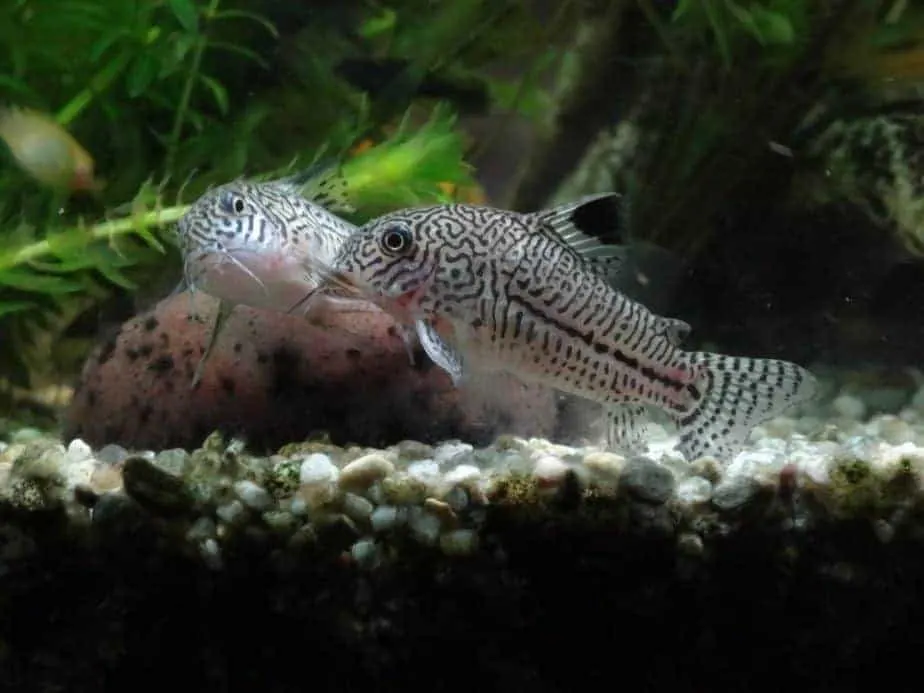
Popular varieties of the corydoras are sterbai, panda, julii, bronze, bandit and skunk corydoras. I personally have corydoras habrosus which is one of the few species that stay rather small.
I would include a table with values for you but this all really depends on what variety of corydoras you choose! Make sure to research the specific fish you plan on buying beforehand.
They are a schooling fish so make sure you keep at least 5 of these fish at the same time.
As you can see on the pictures they have tiny whiskers which they use to look through the substrate. To make sure they stay healthy and undamaged make sure you have fine sand as a substrate instead of sharp or heavy gravel.
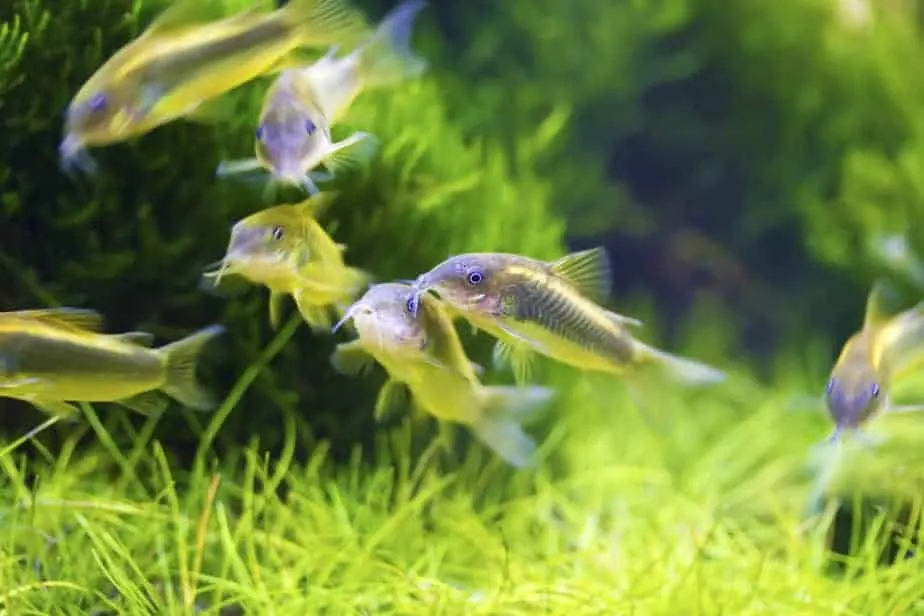
13. Ancistrus / Brislenose Catfish
One of my favorite fish! The bristlenose catfish is often added as an algae eater but in my experience not really good at eating algae. They do find all leftover food even when it falls in between a lot of dense plants. Make sure you do not buy a plecostomus! They are really small and often sold to beginners but grow to be way to big for any community tank! Bristlenose catfish (ancistrus) stay small enough and can remain in a normal tank for their entire life.
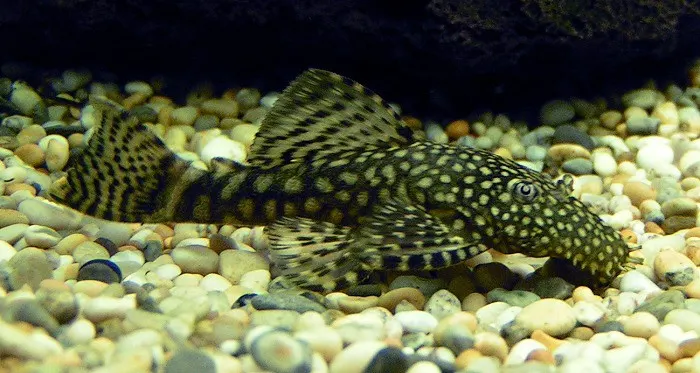
| Temperature | 70-80⁰ Fahrenheit. |
| pH | 6.5 – 7.5 |
| Adult size | up to 5 inches |
| Minimum tank size | 20 gallons for one |
| Tips | Add plenty of hiding spaces and a piece of wood |
In a 20 gallon aquarium there is enough space to add one bristlenose catfish. Buy them small as they are cheapest then. You have to add a piece of wood as they need to be able to “eat” some wood to stay healthy. They are good at eating brown algae but less suitable to eat green algae.
If your tank is big enough for a breeding pair, these fish are actually really easy to breed. The father will guard the eggs and look after the fry.
I highly recommend getting a bristlenose pleco as they are super interesting and special in your tank.
14. Kuhli loaches
These little snails may freak you out or you will find them awesome. They are excellent for eating uneaten food and there is no reason not to buy them. There is one thing: when you have added them to your community tank you are going to have a hard time removing them as they are super tough to catch.
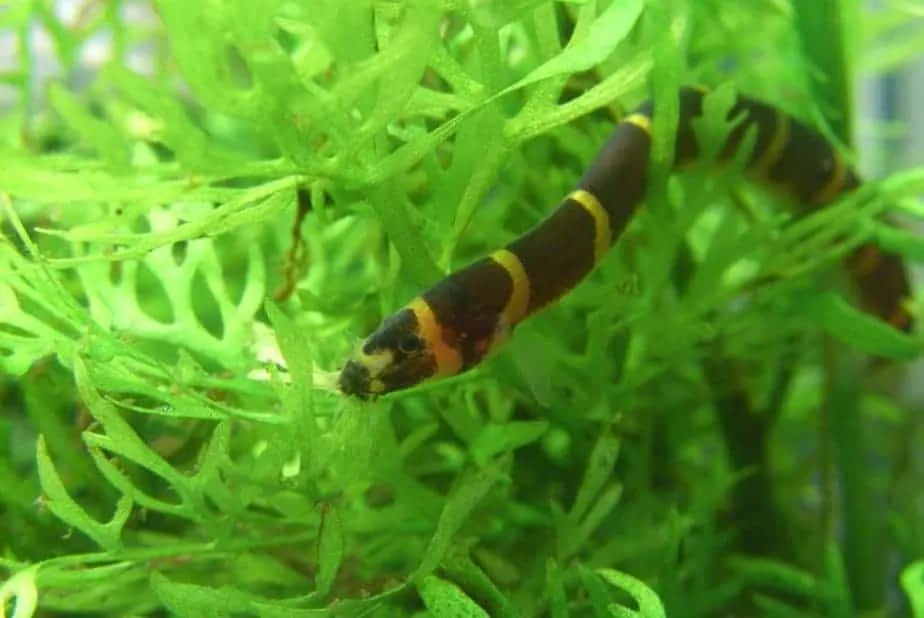
| Temperature | 73-85⁰ Fahrenheit. |
| pH | 5.5 – 6.5 |
| Adult size | 4 inches |
| Minimum tank size | 20 gallons |
| Tips | These little guys prefer good water movement |
These fish can jump so make sure you have a cover over your aquarium. They are used to a lot of vegetation so include plenty of live plants that will provide protected places for them to explore.
They are very peaceful and therefore super suitable as a beginner community fish.
15. Otocinclus
Known to be among the best algae eaters in the aquarium hobby is the otocinclus. They stay rather small and need a school to feel most comfortable. On the picture below you can see a piece of cucumber for scale. They only grow to be about 2 inch adult size.
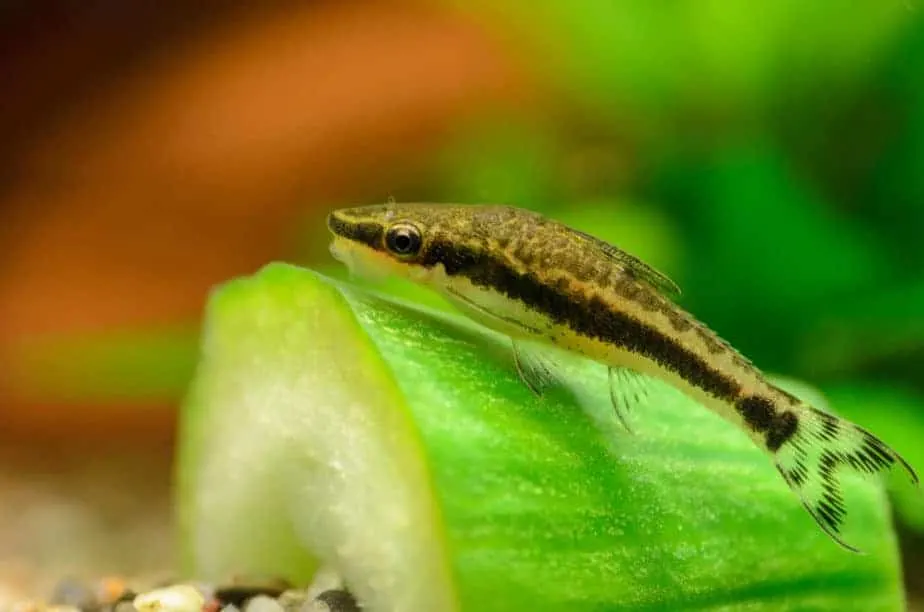
| Temperature | 72-80⁰ Fahrenheit. |
| pH | 6.8 – 7.5 |
| Adult size | 1-2 inches |
| Minimum tank size | 10 gallons |
| Tips | Keep a minimum number of 5 |
These guys are super peaceful and therefore can be together with a lot of other peaceful fish in the same aquarium. They stay rather small so you can house a small group (4 – 6) in a 10 gallon tank.
Algae is one of their main sources of food in nature. Make sure to add supplementary food to your tank when there is not enough algae left for them to feed on.
Do not keep these fish with aggressive fish that might bully them as this will cause a lot of stress to the otocinclus and potentially kill them.
Bonus Critters
Now you’ve got your fish selected, but there are other options such as snails or shrimp. I personally love adding aquarium snails to my tank. There’s much more info on them which you can find here.
16. Snails
While a lot of people think of snails in their aquarium as a infestation, I love them! When kept under control snails are pretty good at eating algae and left-over food. They also dig around in the substrate, essentially aerating it for you. There are many snails available at your local fish store to choose from. The picture below shows a nerite snail which is not able to reproduce in freshwater (they will lay eggs but they will not hatch). They are one of the best algae eaters available.
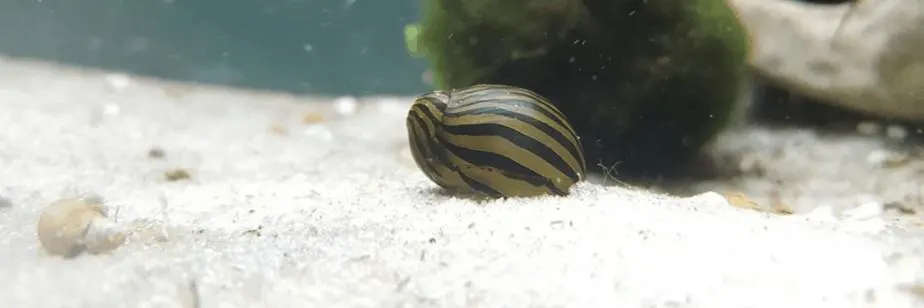
Snails are pretty hardy and just need constant water parameters. I do temperature acclimate my snails and never had a problem. There are people that say that temperature acclimating snails is not necessary, but when I pay 2 bucks for a snail I am going to make sure they do not die because I did not spend 15 minutes floating them.
17. Shrimp
Finally another one of my favorite creatures to add to my community tank are shrimp! There are many varieties available. I personally love the caridina shrimp like the red cherry, orange sakura or blue shrimp. These shrimp actually breed in my aquarium, which means I can sell them back to my local fish store!
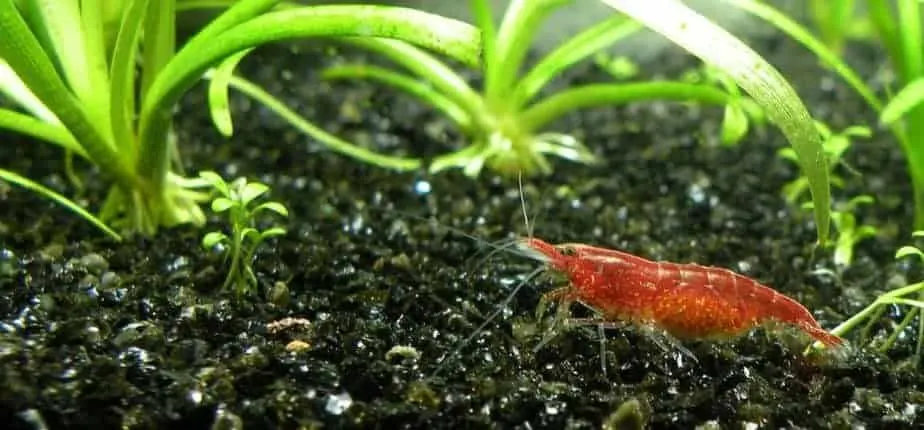
These fish are quite sensitive but I have not had any issues with them yet. Just make sure you do not keep them with a big school of hungry fish as they will sometimes chase them. A big school of fish will definitely eat all the baby shrimp.
In general, these shrimp are busy all the time which is a lot of fun to watch. They can be quite expensive to purchase.
My favorite fishtank products that make life easier
I am so happy you enjoy this post so far! You will also definitely like my product recommendations that will make your fishkeeping experience so much better. I’m 100% sure you’ll love them!
- Without a gravel vacuum, like one from Aqueon, cleaning the substrate of your tanks is near impossible. Whenever I want to remove some of the sunken detritus from the bottom of my acrylic tanks I’m happy I’ve got one of these.
- It’s no secret that I do not like nutritious aqua-soil. It makes a mess and only works for a given amount of time. Instead, I always use a liquid aquarium plant fertilizer. Everyone who keeps live plants needs it, it’s not that expensive and makes your plants grow better.
- I love keeping plants, but planting and reorganizing my aquarium was difficult until I got a set of these tools. It’s much easier to plant any kind of plant compared to using my thick fingers.
- Ever since I’m able to accurately test my water parameters, including the pH level, keeping fish became less stressful. Before I was always stressed that my water parameters were wrong, but with a kit such as the API Master kit, I can measure this. It really is essential to successful fishkeeping.
- The more you know about your aquarium, the better! Temperature is crucial for the health of your fish. A thermometer will also show you whether your heaters are still working correctly. It will give you more insight and more peace of mind. It’s an easy way to ensure that you’re providing your fish with the tropical temperatures they need.
References:
Swordtail image – Author: Wojciech J. Płuciennik Licensed under: Creative Commons Attribution-Share Alike 4.0 Internationa No changes made
Platy image – Author:Dornenwolf Licensed: CC2.0
Harlequin Rasbora image – Author: Juan R. Lascorz Licensed under: CC3.0 no changes made
Tiger Barb image 1 – Author: Editor General of Wiki Licensed under: CC4.0 No Changes made
Angelfish image – Author: Jeff Kubina Licensed under: Some rights reserved No Changes
Corydoras Julli image – Author: h080 Licensed under: Some rights reserved No Changes
Ancistrus image – Image from Sannse licensed under CC 3.0 No changes
Kuhli loach image – Author: Robert Mollik Licensed under: GNU Free Documentation License, No Changes

